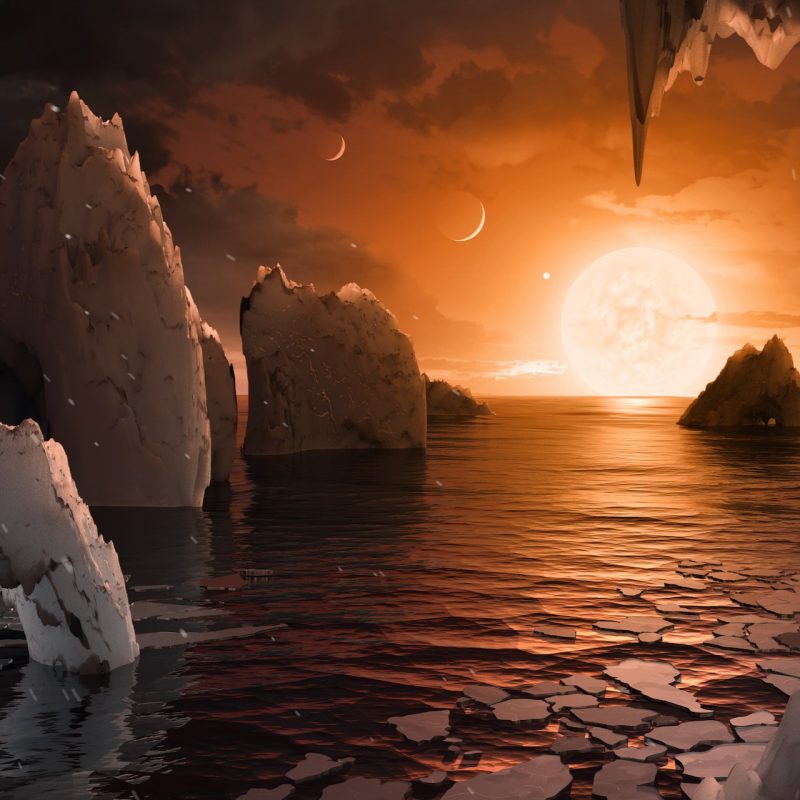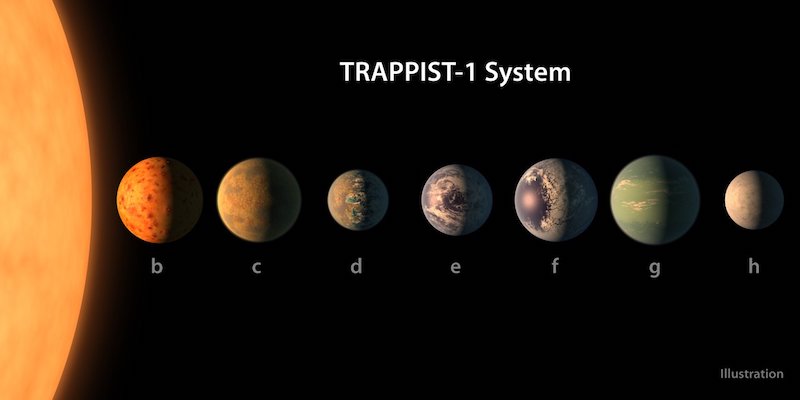
The seven rocky planets orbiting the star TRAPPIST-1 are all close in size to Earth. They’re only 40 light-years away. And they’ve fascinated scientists and the rest of us since their discovery in 2016 and 2017. Three of the seven orbit within their star’s habitable zone. That means liquid water might exist on their surfaces. But does that water truly exist? And are these worlds habitable? We don’t know the answer to either question, yet. But a new study – published in August 2023 – suggests there’s a good chance at least some of the TRAPPIST-1 planets do have water. If so, they might be habitable.
The study – based on a new computer modeling technique – focuses on the evolution of the atmospheres of the TRAPPIST-1 worlds. Astronomer Franck Selsis at the University of Bordeaux led the research team, which published its peer-reviewed findings in Nature on August 9.
What are some of the issues here? One recent finding from the James Webb Space Telescope suggested that the two TRAPPIST-1 planets closest to their star either have no atmospheres, or have only thin atmospheres at best.
Plus, previous studies had suggested that early on, conditions were hot enough to melt the planets’ crust and mantle into magma, making surface water possibilities dim. But the new study suggests that – while the planets’ surfaces surely got hot – a few might still have been able to hold onto their water.
Hotter star and harsh conditions early on
Habitability, as scientists define it today, requires a particular set of conditions. And while the TRAPPIST-1 planets are rocky like Earth – and similar to Earth in size and mass – their parent star is different. It used to be much hotter than it is now. That means that – early in their history – the planets were very hot, too.
Scientists have said that water in the rocks of the TRAPPIST-1 planets, at least those planets closest to such a hot star, probably would have evaporated. That would mean no oceans, no lakes, no rivers. The chances for life as we know it on those worlds would be slim.
Tereza Pultarova wrote about the new study for Space.com on August 10. She quoted Franck Selsis as saying:
Small, red stars like TRAPPIST-1 decrease in luminosity with time. When the TRAPPIST-1 system formed, the planets that are now inside the habitable zone, where water can exist, were for hundreds of millions of years much more irradiated than they are today.
And that means that if they had water, this water would have evaporated.
Did a runaway greenhouse cause a melting crust?
So, even if the planets started with water-rich atmospheres, their history might have made water unlikely today. Earlier studies showed that – if a water-rich TRAPPIST-1 world received only 10% more heat from its star than Earth does from the sun – that extra heat could trigger a runaway greenhouse effect. And water vapor is a greenhouse gas. As temperatures climbed on a TRAPPIST-1 world, water would have evaporated from the rocks. The evaporation, in turn, would have added more water vapor to the atmosphere, causing the temperatures to increase further. And so on.
Eventually, the planet would become hot enough that its crust and mantle would turn into liquid magma.
If that’s what happened, then – at that point – stellar winds from the star would have caused the water vapor in the atmosphere to dissipate into space. The planet would have been left with only a thin atmosphere, if any atmosphere at all.

Or, did the TRAPPIST-1 planets keep their water?
Enter the new study. If its results are correct, then at least some of the TRAPPIST-1 planets might have been able to hold on to their water – and have habitable conditions – after all.
But the conditions would have to be just right.
In previous studies, scientists assumed that a planet’s internal convection could drive the heating of the planet’s atmosphere to the point where the water would be lost and the surface would melt. The new paper explains:
Water vapor atmospheres with content equivalent to the Earth’s oceans, resulting from impacts or a high insolation, were found to yield a surface magma ocean.
But – in the new study – scientists found that the magma ocean would only result if the planet had what they called “a fully convective structure.” Convection is what happens in a pan of water boiling on your stove. It’s the movement that happens within a fluid (in this case molten rock) as hotter and less dense material rises, and colder, denser material sinks. The new study suggests that at least some TRAPPIST-1 planets might not be “fully convective.” Selsis said:
We were not completely happy with the convective assumption. One reason for that is that with very deep atmospheres, there will be little light reaching the surface. Probably not enough to drive convection.
Without the “fully convective” assumption – in the new computer model used by these scientists – the surfaces of some TRAPPIST-1 worlds should remain cool enough for water to remain.
Specifically, although habitable conditions seem unlikely for the two innermost planets, TRAPPIST-1 b and TRAPPIST-1 c, it still might be possible on other planets farther from the star.

Waiting for more Webb results
So, essentially, scientists agree that the TRAPPIST-1 planets did start off hotter and more irradiated than they are today. But the new study shows they might not have become too hot to be uninhabitable.
Scientists are counting on NASA’s James Webb Space Telescope to provide some additional insights. One of the main uses of the space telescope is to study the atmospheres of exoplanets, to search for signs of life elsewhere in the universe.
It will be very interesting to see what Webb shows!
Bottom line: In a new study, astronomers say that at least some of the seven Earth-sized TRAPPIST-1 exoplanets could be habitable now, even if they didn’t start out that way.
Source: A cool runaway greenhouse without surface magma ocean
Read more: Wow! Nearby TRAPPIST-1 has 7 planets
Read more: TRAPPIST-1 worlds likely terrestrial and water-rich











